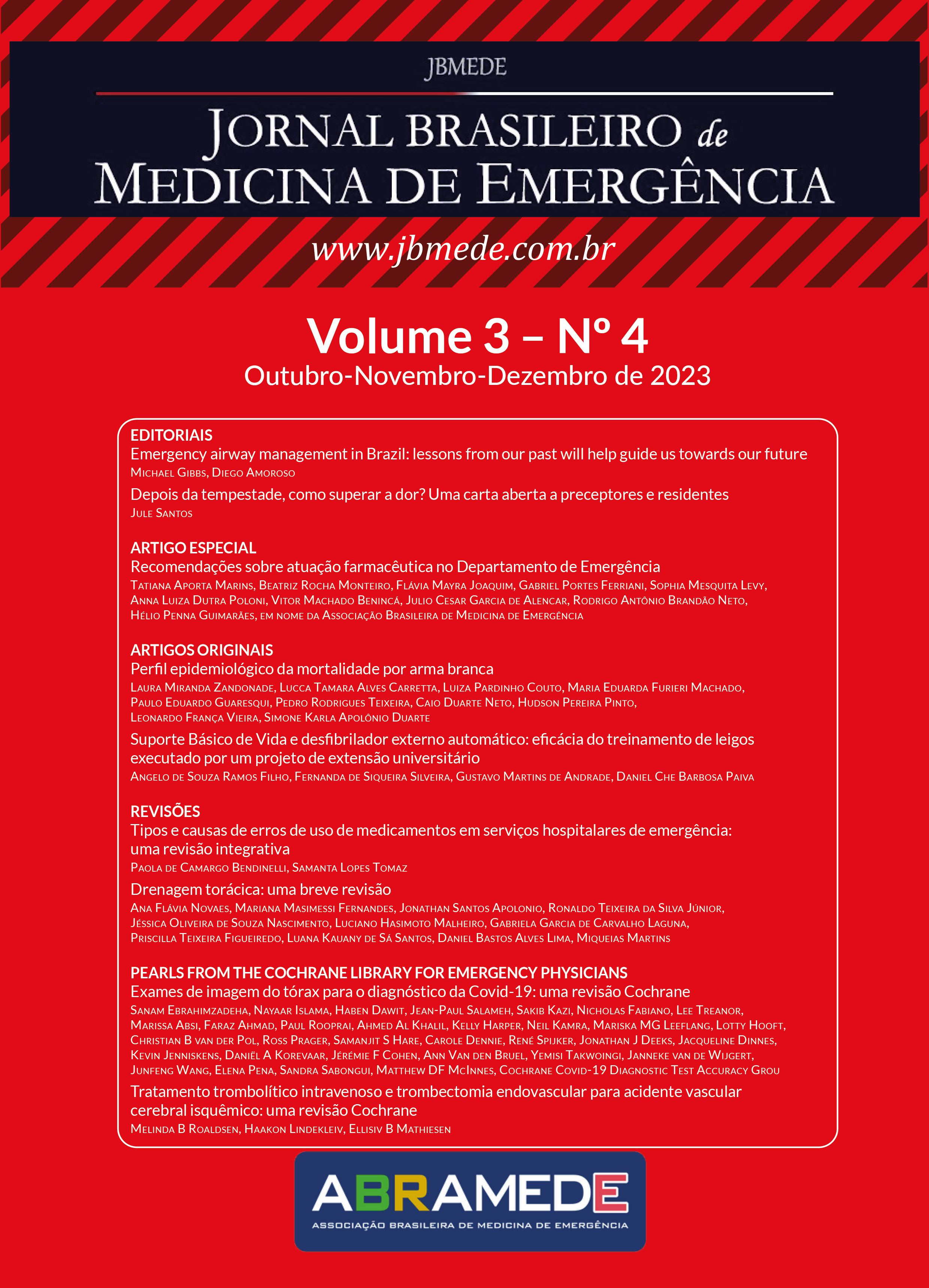Thoracic drainage: a brief review
Main Article Content
Abstract
Thoracic drainage is a medical procedure that is intended to remove gases, blood or fluids from the pleural space of patients in whom it is necessary to recover their lung expansion. Generally used after the occurrence of trauma, which has increased in recent decades and is considered a public health problem in several countries, it is an increasingly used technique in the hospital urgency and emergency sectors. This article aims, through a literature review, to describe the main indications and contraindications for chest drainage, the technique of the procedure and its complications. The literature demonstrates that chest drainage is indicated in situations of hemothorax, pneumothorax, empyema, chylothorax and recurrent pleural effusion, and that it should be used with care in cases of uncorrected coagulopathy, absence of instrumentation and guidance by images and dermatological infections. Complications can be divided into infectious or related to incorrect technique, demonstrating that not only medical professionals, but the entire surgical team must be constantly trained and updated regarding the processes involved in all stages of patient care.
Article Details

This work is licensed under a Creative Commons Attribution 4.0 International License.
References
Nishida G, Sarrão BD, Colferai DR, Tenório GO, Bandeira CO.
Cuidados com o sistema de drenagem torácica em adultos
internados no Hospital Universitário Regional de Maringá, Estado
do Paraná, Brasil. Acta Scientiarum. Health Sciences. 2011; 33(2),
-179. Acesso em 22 de julho de 2022.
Porcel JM. Chest Tube drainage of the pleural space: a
concise review for pulmonologists. Tuberc Respir Dis (Seoul).
;81(2):106-15.
Toth JW, Reed MF, Ventola LK. Chest tube drainage devices. Semin
Respir Crit Care Med. 2019;40(3):386-93.
Brasil. Ministério da Saúde. Uma análise da situação de saúde e das
doenças e agravos crônicos: desafios e perspectivas. Brasília, DF:
Ministério da Saúde; 2019 [citado 2024 jan 16]. Disponível em:
https://pesquisa.bvsalud.org/bvsms/resource/pt/mis-40352
Zanette GZ, Waltrick RS, Monte MB. Perfil epidemiológico do
trauma torácico em um hospital referência da Foz do Rio Itajaí.
Revista do Colégio Brasileiro de Cirurgiões. 2019;46(2).
Celino SD, Nunes WB, Macedo SM, Silva SB, Andrade FB.
Morbimortalidade por causas externas no Brasil entre 2015 e
: um estudo ecológico. Ciência Plural, 2021;3(7):180-201.
Guimarães HP, Lopes RD, Lopes AC. Tratado de medicina de
urgência e emergência pronto-socorro e UTI: edição atualizada.
São Paulo: Atheneu, 2010.
Shiose A, Takaseya T, Fumoto H, Arakawa Y, Horai T, Boyle EM, et
al. Improved drainage with active chest tube clearance. Interact
Cardiovasc Thorac Surg. 2010;10(5): 685-8.
McDermott S, Levis DA, Arellano RS. Chest drainage. Semin
Intervent Radiol. 2012;29(4):247-55.
Nwagboso CI, Echieh CP, Eze JN, Ogbudu SO, Njoku CH,
Etiuma AU, et al. Predictors of outcome of chest tube drainage
of nonpurulent exudative pleural effusions. ERJ Open Res.
;8(2):00604-2021.
Huggins JT, Carr SR, Woodward GA. Thoracostomy tubes and
catheters: Indications and tube selection in adults and children.
Uptodate. 2023 [cited 2024 Jan 16]. Available from: https://www.
uptodate.com/contents/thoracostomy-tubes-and-cathetersindications-
and-tube-selection-in-adults-and-children
McElnay PJ, Lim E. Modern techniques to insert chest drains.
Thorac Surg Clin. 2017;27(1):29-34.
Kesieme EB, Dongo A, Ezemba N, Irekpita E, Jebbin N, Kesieme
C. Tube thoracostomy: complications and its management. Pulm
Med. 2012;2012:256878.
Laws D, Neville E, Duffy J; Pleural Diseases Group, Standards of
Care Committee, British Thoracic Society. BTS guidelines for the
insertion of a chest drain. Thorax. 2003;58(Suppl 2):ii53-9.
Ellis H. The applied anatomy of chest drain insertion. Br J Hosp
Med (Lond). 2007;68(3): M44-5.
Kesieme EB, Olusoji O, Inuwa IM, Ngene CI, Aigbe E. Management
of chest drains: a national survey on surgeons-in-training
experience and practice. Niger J Surg. 2015;21(2):91-5.
Dev SP, Nascimiento B Jr, Simone C, Chien V. Videos in clinical
medicine. Chest-tube insertion. N Engl J Med. 2007;357(15):e15.
Symbas PN. Chest drainage tubes. Surg Clin North Am.
;69(1):41-6.
Miller KS, Sahn SA. Chest tubes. Indications, technique,
management and complications. Chest. 1987;91(2):258-64.
Mendes C, Hirano, E. Fatores preditores de complicações da
drenagem de tórax em pacientes vítimas de trauma. Rev Col Bras
Cir. 2018;45(2):e1543.
Havelock T, Teoh R, Laws D, Gleeson F; BTS Pleural Disease
Guideline Group. Pleural procedures and thoracic ultrasound:
British Thoracic Society Pleural Disease Guideline 2010. Thorax.
;65 Suppl 2:ii61-76.
Merkle A, Cindass R. Care of a chest tube. 2023 Jan 22. In:
StatPearls. Treasure Island (FL): StatPearls Publishing; 2023 Jan–.
PMID: 32310548.
De Azambuja MI, De Castro Júnior MA. Drenagem torácica.
VITTALLE-Revista de Ciências da Saúde. 2021;33(1):147-58.
Baumann MH, Strange C, Heffner JE, Light R, Kirby TJ, Klein J,
et al.; AACP Pneumothorax Consensus Group. Management
of spontaneous pneumothorax: an American College of Chest
Physicians Delphi consensus statement. Chest. 2001;119(2):590-
Tang AT, Velissaris TJ, Weeden DF. An evidence-based approach
to drainage of the pleural cavity: evaluation of best practice. J Eval
Clin Pract. 2002;8(3):333-40.
Baumann MH. What size chest tube? What drainage system is
ideal? And other chest tube management questions. Curr Opin
Pulm Med. 2003;9(4):276-81.
Araújo DC, Silva IM, Araújo RC, Jesus EC. Drenagem torácica em
condições traumáticas e não traumáticas e suas complicações.
Caderno UniFOA. 2021.
Mendes CA, Hirano ES. Predictors of chest drainage complications
in trauma patients. Revista do Colégio Brasileiro de Cirurgiões.
;45(2):10-5.
Scomparin TP, Domenicali DC, Nakano LC. Drenagem torácica:
intervenções da equipe de enfermagem. VI EPCC - Encontro
Internacional de Produção Científica (27 a 30 de Outubro de
. 2009 [citado 2024 Jan 16]. Disponível em: https://rdu.
unicesumar.edu.br/xmlui/handle/123456789/6222
Aziz F, Penupolu S, Flores D. Efficacy of percutaneous
pigtail catheters for thoracostomy at bedside. J Thorac Dis.
;4(3):292-5.
Chang SH, Kang YN, Chiu HY, Chiu YH. A systematic review and
meta-analysis comparing pigtail catheter and chest tube as the
initial treatment for pneumothorax. Chest. 2018;153(5):1201-12.
Wei YH, Lee CH, Cheng HN, Tsao LT, Hsiao CC. Pigtail catheters
versus traditional chest tubes for pneumothoraces in premature
infants treated in a neonatal intensive care unit. Pediatr Neonatol.
;55(5):376-80.
Dull KE, Fleisher GR. Pigtail catheters versus large-bore chest
tubes for pneumothoraces in children treated in the emergency
department. Pediatr Emerg Care. 2002;18(4):265-7.

